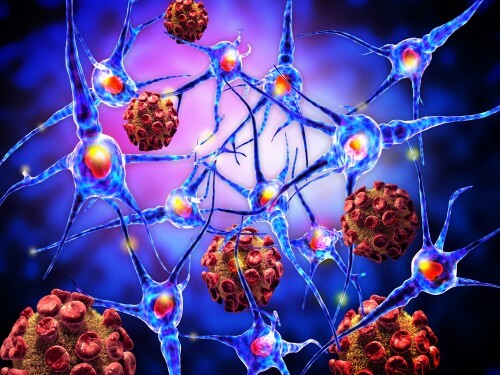As baby boomers, born after World War II, begin to suffer from neurodegenerative diseases that come with age, researchers are focusing on a new direction for treatment: directing the passage of disordered proteins from cell to cell

The first step to treating or preventing a disease is often to find what is causing it. The discovery of the cause of neurodegenerative disorders, made 20 years ago, changed the field: the disorders, Alzheimer's, Parkinson's, Huntington's, motor neuron degeneration (ALS or Lou Gehrig's disease), are all related to the accumulation in the brain cells of proteins whose folding is incorrect.
Credit: Thomas Dierink, ScienceSource
Accumulation of misfolded proteins in brain cells, such as the healthy cells in the picture, is a hallmark of neurodegenerative diseases.
Normally, when a protein folds incorrectly the cell breaks it down, but with age this quality control mechanism weakens and the harmful proteins accumulate. In Huntington's disease, for example, the huntingtin protein, which has many functions in the cell, misfolds and accumulates in the cells. Symptoms such as difficulty moving the muscles, irritability, memory loss, poor impulse control and cognitive decline accompany the accumulation of the disrupted protein.
Accumulating evidence suggests that neurodegeneration progresses not only due to the accumulation of faulty proteins in cells but also due to the movement of these proteins from cell to cell. Researchers have seen disordered proteins migrating between cells in Alzheimer's and Parkinson's patients. A series of experiments whose results were published in August 2014 in the journal Nature Neuroscience showed that the phenomenon also occurs in Huntington's disease.
Experiments conducted by researchers in Switzerland demonstrated that the huntingtin protein that has been disrupted due to mutation, found in diseased brain tissue, is able to invade nearby healthy brain tissue. When the team injected a disrupted protein into the brain of a living mouse, it spread through the nerve cells within a month. This spread is similar to how prions spread, says Francesco Paolo Di Giorgio of the Novartis Institutes for Biomedical Research in Basel, who led the study. Prions are misfolded proteins that migrate through the body and impart their disease-causing properties on normal proteins, as in mad cow disease. However, according to Di Giorgio, it is still not clear whether even in Huntington's disease faulty proteins affect normal proteins as in the case of real prions.
Scientists have yet to establish the hypothesis that the movement of the disrupted proteins is necessary for the progression of the disease, says Albert La Speda, a geneticist at the University of California, San Diego, who did not participate in the study. But if it turns out that migration is indeed essential, it will be possible to focus the treatment of the disease on the path of migration. According to him, "If we can find out how this happens, maybe we can find treatments that will prevent it." And if we succeed, we may be able to apply these treatments to other neurodegenerative diseases as well.
The next step is a crucial one. Researchers will try to block the spread of the disordered proteins and examine whether this improves the symptoms or prevents the progression of the disease. Finding treatments for these diseases is of utmost importance. About 50,000 new cases of Parkinson's disease alone are diagnosed each year in the US, and experts estimate that the incidence will at least double by 2030 due to the aging of the population.
